Listen to This Article:
You may think a knife is just something to slice through meats and veggies but don’t tell that to a chef. A chef’s knife kit is akin to a painter’s brush collection; while any knife can cut and any paintbrush can apply paint, selecting the right tool for the job can help a professional achieve the results they’re looking for.
And the right knife choice is about more than aesthetics—it’s also about safety and efficiency. If you understand which knives to use for different tasks, you may be able to prevent injuries and save yourself time and effort in the kitchen.
A Beginner’s Guide to the Different Types of Chef Knives and How to Use Them
From utility and paring knives to specialty blades like cleavers, there’s a tool designed for each culinary task. Some knife types are built for precision work like peeling fruit or mincing garlic, while others are made for heavy-duty tasks like breaking down meat or slicing crusty bread.
In this guide, we’ll cover the most common types of knives found in a chef’s toolkit, explain what each is used for, and offer tips to help you choose the right knife for your task. Let’s start with one of the most important tools in the kitchen, the chef’s knife.
Chef’s Knife

A chef’s knife is one of the most frequently used tools in the kitchen.
One of the most frequently used and versatile tools in the kitchen, the chef’s knife is typically between eight and ten inches, although it can be as short as six inches and as long as 14 inches. You can probably use your chef’s knife for most of your work during food prep, and in many ways, it can be the most important tool you use.
The more comfortable you feel with the weight and balance, the more quickly you’ll be able to slice, dice, and julienne vegetables during prep for a busy meal service. Therefore it’s important to find a knife that gives you a smooth and fast rhythm as you’re cutting.
Best for: Rock chopping, slicing, dicing, julienning, chiffonade
Commonly used with: Onions, carrots, herbs, melons, poultry, cabbage
Types of Chef Knives: Western vs. Japanese Blades
Your needs and budget are key factors when deciding upon which chef’s knife to invest in, and you’ll quickly discover a popular topic among home chefs and professionals alike: Western or Japanese?
Japanese knives are thinner, lighter, and sharper, and typically thought of as slicers. They’re useful for making precision cuts, particularly in softer foods like fish or when trimming meat. A Japanese knife typically has a straighter blade, making it good for slicing but less useful if you’ll be chopping and dicing a lot.
Made from harder material than the Western knife—Japanese steel ranks higher on the Rockwell hardness scale, a rating for measuring the hardness of material. While the Japanese chef knife can stay sharp for longer, it may also be more brittle and needs to be sharpened using a whetstone rather than a honing rod.
Western knives, sometimes referred to as German-style knives, tend to have a thicker blade and more heft. The blade has more of a curve to it, allowing for a rocking that makes it easier to use for repetitive chopping, and it’s usually heavier than a Japanese knife. It’s typically a good choice if you’ll be chopping carrots and other hardy vegetables.
Japanese Knife vs Western Knife
| Japanese Knife | Western Knife |
|---|---|
Advantages:
Disadvantages:
|
Advantages:
Disadvantages:
|
Paring Knife
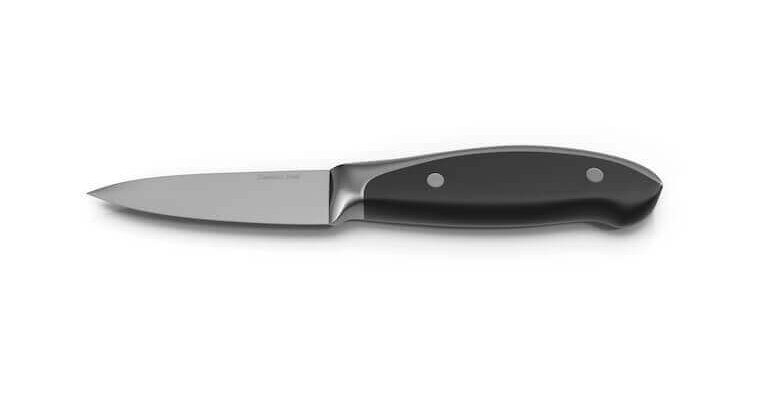
A paring knife is ideal for detail work and when working with small or tender vegetables.
A paring knife is basically a mini chef’s knife with a small blade that offers greater versatility and precision. While the chef’s knife works for cutting hard vegetables, paring knives are great for peeling apples and potatoes, mincing small amounts of garlic and onions, and coring tomatoes.
The blade will be no longer than 3.5 inches, so it’s ideal for detail work like creating a garnish. A paring knife is useful when you’re working with small or tender vegetables and fruit – like ginger, strawberries, garlic, and shallots – but isn’t suited for harder vegetables – such as carrots, beets, and squash.
Remember that you never want to apply force with a paring knife – so if you find yourself flexing your muscle, swap it out for a heavier blade to avoid injury.
Best for: Peeling, trimming, coring, segmenting citrus, mincing small items
Commonly used with: Apples, strawberries, garlic, shallots, potatoes, citrus
Utility Knife
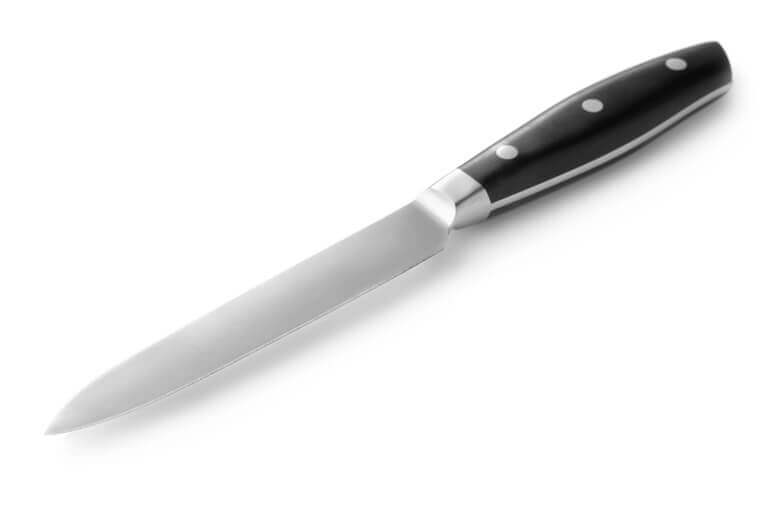
A utility knife is handy for a variety of cuts.
This truly is a utilitarian knife – it does multi-duty. If you want the heft of a chef’s knife with a bit of the precision of a paring knife, the utility knife is the tool to call on. The blade is longer than a paring knife and narrower than a chef’s knife. A utility knife is generally six inches long and works well for slicing fruit, tender pieces of meat, or sandwiches. As the “knife of all trades,” it’s a handy go-to for the everyday chef.
Best for: Slicing sandwiches, soft produce, small cuts of meat
Commonly used with: Cucumbers, peaches, deli meats, cheese, bread rolls
Boning Knife

Boning knives help chefs remove meat from the bone or skin and bones from poultry and fish.
Long, thin, and strong, this knife is used to remove meat from the bone. Its thinness allows you to move with the curves and bends of the bone and separate the meat effectively, creating as little food waste as possible. When using a boning knife, it’s important that you do not attempt to cut through bones.
There are two versions of a boning knife – flexible and stiff – and both have a specific purpose. If you look at a chef’s knife kit, you’ll likely find both in their collection. Both types of knives have five- to six-inch-long narrow blades that come to a very sharp point. This type of flexible blade is suitable for removing skin and bones from poultry and fish, while a stiff blade knife allows you to use greater force when you’re working with thick cuts of meat like beef and pork.
Best for: Removing bones and skin, trimming meat
Commonly used with: Poultry, pork loin, whole fish, beef cuts
Bread Knife
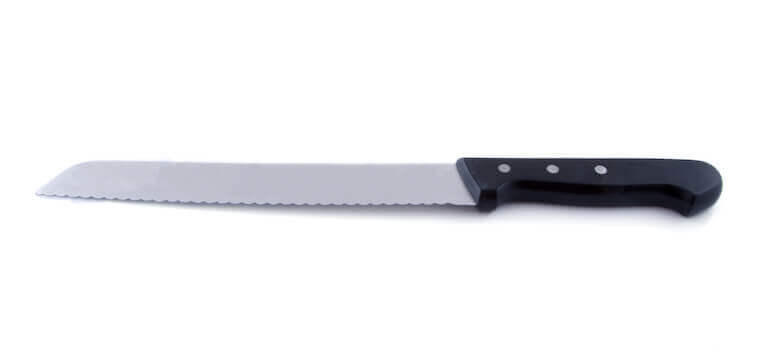
The serrated edges of a bread knife are good for slicing bread as well as soft fruits and vegetables.
The serrated edge of a bread knife lets it slice bread without ruining the crumb structure or tearing the loaf apart.
The saw-like blade is ideal when you want to cut something without applying pressure. While a bread knife is great for gently slicing fresh bread, it also works well with soft fruits and vegetables, or ones with a waxy surface. By using a gentle sawing motion, you can use a serrated knife to effectively cut through the surface of a tomato, orange, or strawberry without crushing the insides. However, the cut won’t necessarily look as clean as the one you’ll get with a chef’s knife.
Keeping a bread knife sharp can be a challenge because you need a special sharpener to sharpen each surface of the jagged blade. However, learning this special skill is worth the effort to maintain a sharp knife.
Best for: Sawing through soft or crusty surfaces without crushing it
Commonly used with: Bread, tomatoes, oranges
Carving Knife
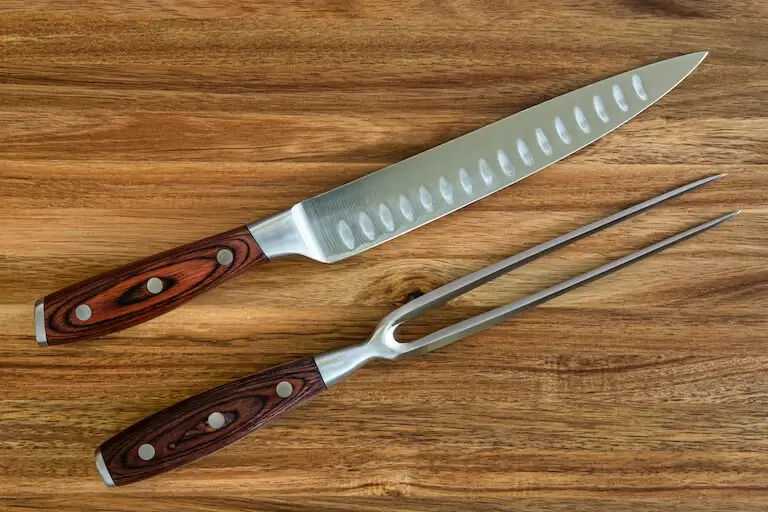
A carving knife helps chefs achieve precise cuts on meat.
When it comes time to achieve a clean, precise cut on a turkey, ham, or beef, the carving knife is ideal. A good carving knife is usually fifteen inches long. Its thin blade often features an indentation that stops food from sticking to the surface. Whether you’re slicing a sirloin roast into paper-thin slices or a pork tenderloin into thick, juicy portions, a carving knife is the perfect tool.
Best for: Slicing cooked meats into clean, uniform pieces
Commonly used with: Turkey, ham, brisket, roast beef, pork tenderloin
Cheese Knife
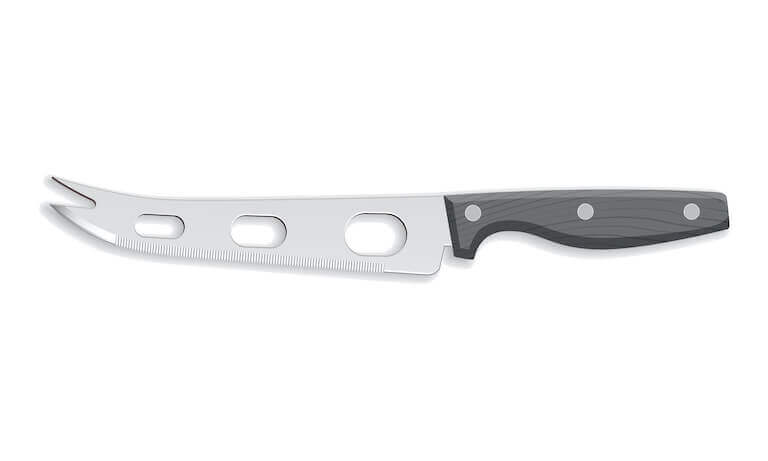
Many cheese knives have holes to prevent the cheese from sticking to them.
Soft cheeses like brie and Roquefort often stick to solid knives, which is why many cheese knives have holes in them. These holes reduce the cheese’s surface contact with the blade, which cuts down on any sticking. While these knives work optimally on soft cheeses, they aren’t necessarily the best choice for hard cheeses like Parmigiano Reggiano.
Best for: Cutting soft or crumbly cheeses without sticking
Commonly used with: Camembert, brie, blue cheese, feta
Tomato Knife
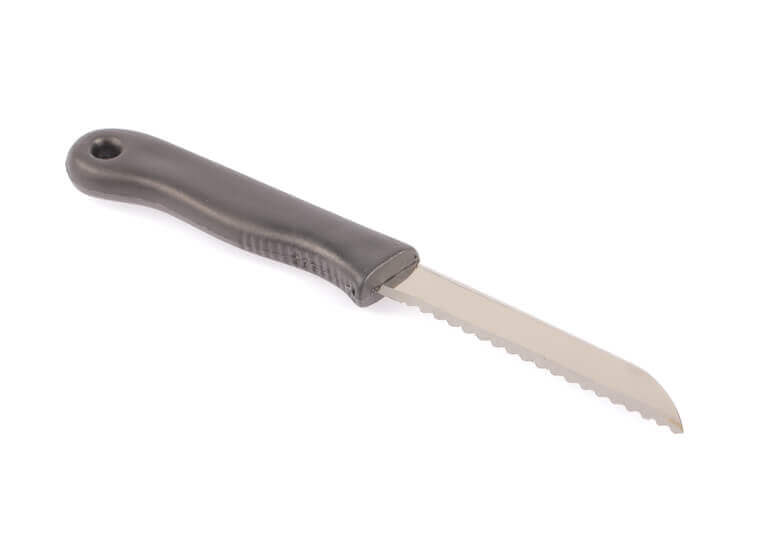
A tomato knife helps chefs cut tomatoes without tearing the skin.
Tomatoes are notoriously hard to slice because their skin is prone to tearing, and their interior is easily squashed. Very small serrations on the tomato knife’s blade grip the skin of the tomato and reduce tears, allowing you to easily slice through the skin while preserving the tomato’s fragile texture. A tomato knife is typically smaller than a bread knife, making it easier to handle when cutting small tomatoes.
Best for: Slicing tomatoes cleanly without crushing
Commonly used with: Tomatoes, kiwis, plums, nectarines
Cleaver
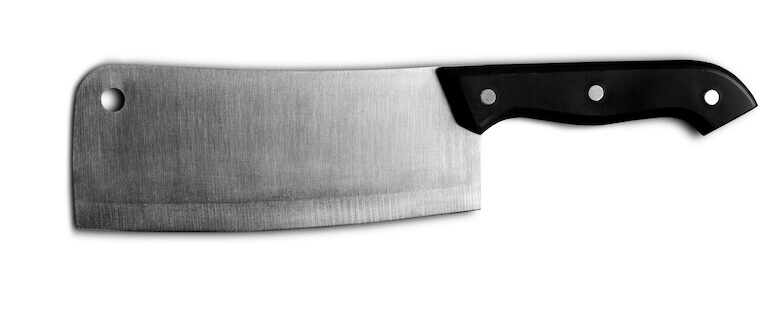
A cleaver is a heavy, sharp knife that can cut through bones.
Cleavers are heavy, sharp knives used to cut through bones. While this knife isn’t particularly common in home kitchens, many chefs in restaurants use them so they can have total control over their cuts of meat.
The chef’s knife reigns supreme in Western kitchens, but in China the cleaver may take the place of everything from a paring knife to a chef’s knife. Therefore, if you’re interested in investing in a multi-use cleaver, consider a Chinese-style one. These knives are lighter than their American counterparts, making them useful for many more kitchen tasks.
Best for: Cutting through bone and tough meats
Commonly used with: Pork shoulder, chicken wings, hard squash, ribs
Mincing Knife
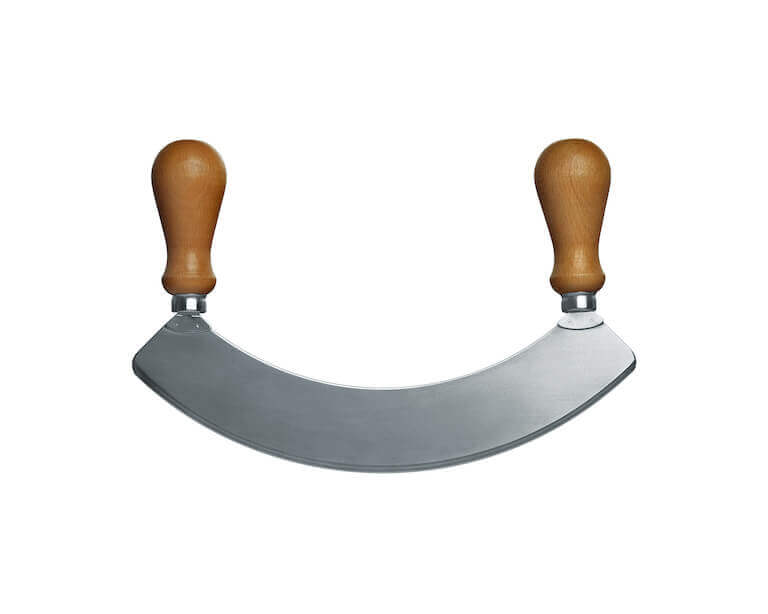
A mincing knife is useful for quickly chopping vegetables or herbs into small pieces.
A mincing knife is a curved knife that is held with both hands and used by rocking it back and forth. This knife can quickly mince vegetables or herbs with minimal effort. However, it doesn’t offer the precision of a chef’s knife.
Best for: Rapid chopping and mincing with a rocking motion
Commonly used with: Herbs, garlic, onions, mushrooms
Decorating Knife
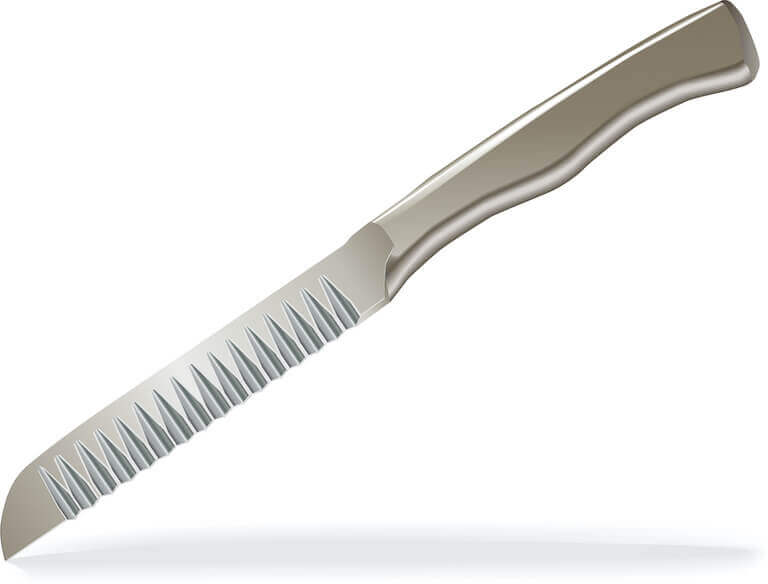
A decorating knife has a pattern in the blade that appears on the food it cuts.
If a chef wants their food to have a designed edge (for example, zig-zag pattern), they can use a decorating knife. Decorating knives have patterns in the blade that appear on the foods they cut. For example, you might use one to quickly slice potatoes with ridges for making chips.
Best for: Creating decorative edges or patterned cuts
Commonly used with: Potatoes, cucumbers, soft cheeses
Caring for the Different Types of Knives
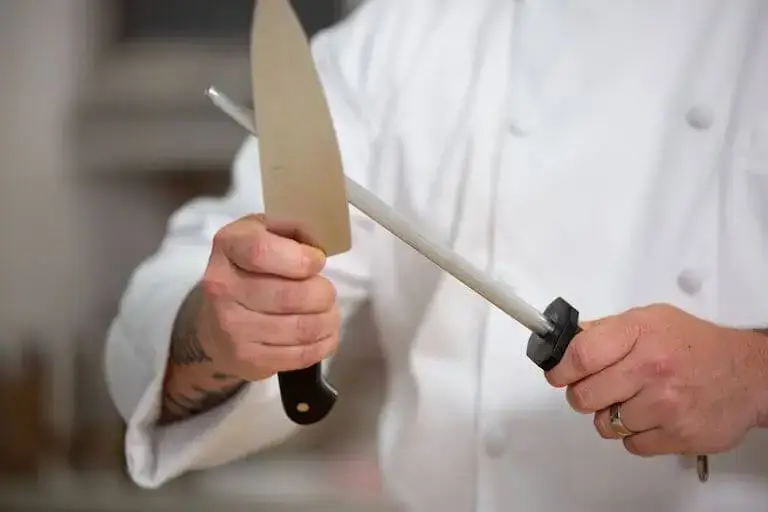
A honing rod should be used regularly to keep knives sharp.
It’s important to have the right knife for the job, but just as important to have the right tool to keep a sharp edge on your knives. While you can send your knives out to a professional knife sharpener, you can also learn how to reset the edge between sharpening with a honing rod.
There’s a technique to using a honing rod that will work with all your knives – except your serrated knives. Be sure to hone them before or after a session in the kitchen, at least weekly. Not only can dull blades slow you down, but they can also increase the risk of injury.
Start with Proper Knife Skills
Even if you have the ideal knife for each job, a set of knives is only as good as the person using them. That’s why culinary students at Auguste Escoffier School of Culinary Arts can start their programs by exploring and practicing their knife skills. With a proper knife kit and the skills to match, students can then move on to tackling more culinary techniques.*
If you’re interested in discovering more about how culinary school can help you become familiar with new tools and techniques, contact us today.
LIKE THIS ARTICLE? YOU MAY ALSO LIKE:
- Culinary School Pros and Cons: How to Decide If It’s For You
- How to Carve a Chicken Like a Professional Chef
- Baking Basics: Essential Baking Tips & Techniques for Beginners
This article was originally published on January 22, 2021, and has since been updated.
*Information may not reflect every student’s experience. Results and outcomes may be based on several factors, such as geographical region or previous experience.

